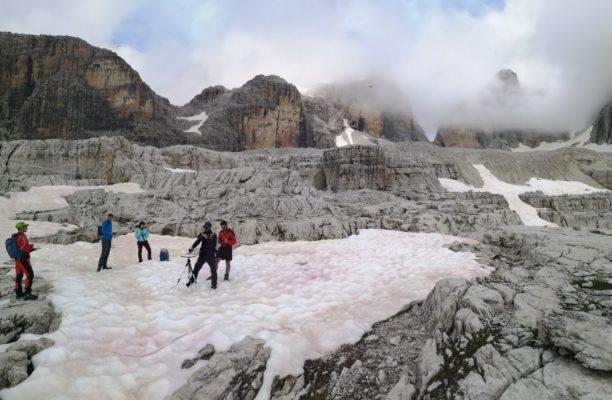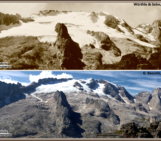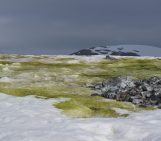
We are used to think of algae as marine or lacustrine organisms, but they are actually able to thrive also on the cryosphere. In a previous post, we learnt how snow algae live and reproduce on snow. Now we will explore how and why scientists study snow algae, and how social media can be used for identifying new study areas.
Snow algae in the Alps
Snow algae in the Alps have been overlooked or confused with dust for a long time. Papers on this topic are sparse, and only recently snow algae were recognized to play an important role both in Arctic and Antarctic ecosystems. In fact, red algae adapted to snow (Figure 2) are able to efficiently absorb solar radiation and to enhance snow melt through a process called albedo feedback. If you do not know what the albedo is, well it is a measure of the ability of a surface to reflect or absorb solar radiation. While other processes can also induce a darkening of snow and ice (a reduction of the albedo), the one induced by snow algae is one of the most intriguing. For their development, snow algae need at least three factors: nutrients, liquid water and solar radiation. If just one of these factors is lacking, then algae will probably not develop.
The physiological and ecological properties of snow algae are not well known, and their occurrence on Alpine snow fields is very aleatory and unpredictable. Several variables can be involved in the occurrence of a snow algal bloom. Among them we report geomorphology, geology and soil composition of the underlying ground. Nivo-meteorological variables are also possibly relevant, such as: snow depth, snow density and snow liquid water content. Studying snow algae is not an easy task, since their occurrence on snow field is very hard to forecast and also sparse both from the spatial and temporal points of view.In the following section, I will explain how I got involved in the research on snow algae, and how my colleagues and I developed a “citizen science” project to find a good location for an intensive field campaign in July 2021.
Hunters and gatherers
The hunt
My colleague Roberto Garzonio and I started to be interested in cryospheric algae a few years ago. We stepped into snow algae blooms in the Alps during our campaigns or expeditions in snowfields, and we got curious about this phenomenon. Looking on the internet, we realized that only a few studies on snow algae existed in the Alps, and none of them were concerned with the impact of algae on snow albedo and melting.
The first time we managed to measure the albedo of snow during an algal bloom, we were in Torgnon, Aosta Valley (western Italian Alps), where a monitoring site managed by the Environmental Protection Agency of Aosta Valley is available. That place is really perfect for snow and ecosystem studies, but unfortunately snow algae do not develop each year at this site. So, we decided to find another study site for our analysis. With the help of a local glaciological commission (Commissione Glaciological SAT), we prepared a post for their Facebook profile to ask for help from hikers and mountaineers. The idea was to map the locations of snow algae blooming across the Italian Alps thanks to their reports. This would have helped us in identifying the environmental conditions that favor or allow the development of red algae on melting snow. Following this approach, we also aimed at finding the best place for organizing a field campaign. To help mountaineers and hikers to correctly identify red snow algae, we provided in the post some example pictures (Figure 3) of red algae on snow. Moreover, we asked them to send us the location and timing of the spotted events. The post got more than 40K views, and about 70 reports were received during summer 2021. With this information, our colleagues from SAT created a dynamical map that spatially represented all sightings. Then we carefully analyzed all sites to find the best one for conducting our field campaign.
The gathering
In the reports that we received, the area of the Brenta group in the Dolomites was repeatedly identified as an “hot spot” for red algae. The location of the campaign should be rather flat and easily reachable. For this reason, we selected the proglacial snowfield of the Vedretta degli Sfulmini (a glacier in the Dolomites) in the Adamello-Brenta National Park. This is a truly ice gem, a small glacier nestled between impressive rock walls.
The team (Figure 4) was composed by myself Biagio Di Mauro (researcher from the National Research Council of Italy), Roberto Garzonio (PhD technician from the University of Milano-Bicocca, UNIMIB), two Earth Sciences undergraduate students (Federico Besana and Giorgia Greco, from UNIMIB), and Gabriele Bramati, a former UNIMIB research fellow (now master student at University of Olso). The president of the Commissione Glaciologica SAT, Cristian Ferrari, also joined the group.

Figure 4. The team that participated the snow algae campaign in the Brenta group. From left to right: Cristian Ferrari, Giorgia Greco, Federico Besana, Biagio Di Mauro, Gabriele Bramati and Roberto Garzonio. [credit: Roberto’s drone]
See you next summer! Maybe on a patch of red snow…

Figure 5. The team is collecting field data on the snowpack in the proglacial plain of the Vedretta degli Sfulmini. [Credit: Cristian Ferrari]
Further reading
- Hoham & Remias (2020), Snow and Glacial Algae: A Review. J. Phycol. 56:264-282, DOI: 10.1111/jpy.12952.
- Remias et al. (2005) Photosynthesis, pigments and ultrastructure of the alpine snow alga Chlamydomonas nivalis. European Journal of Phycology 40:259-268, DOI: 10.1080/09670260500202148.
- Stewart et al. (2021) Altitudinal Zonation of Green Algae Biodiversity in the French Alps. Front. Plant Sci. 12:679428, DOI: 10.3389/fpls.2021.679428
Edited by Francesco Avanzi and Giovanni Baccolo
 Biagio Di Mauro is a researcher at the Institute of Polar Sciences, National Research Council of Italy. He studies the optical and thermal properties of snow and ice through satellite images, drones and field spectroscopy. He tweets as @DiMauro_b. Contact Email: biagio.dimauro@cnr.it
Biagio Di Mauro is a researcher at the Institute of Polar Sciences, National Research Council of Italy. He studies the optical and thermal properties of snow and ice through satellite images, drones and field spectroscopy. He tweets as @DiMauro_b. Contact Email: biagio.dimauro@cnr.it






